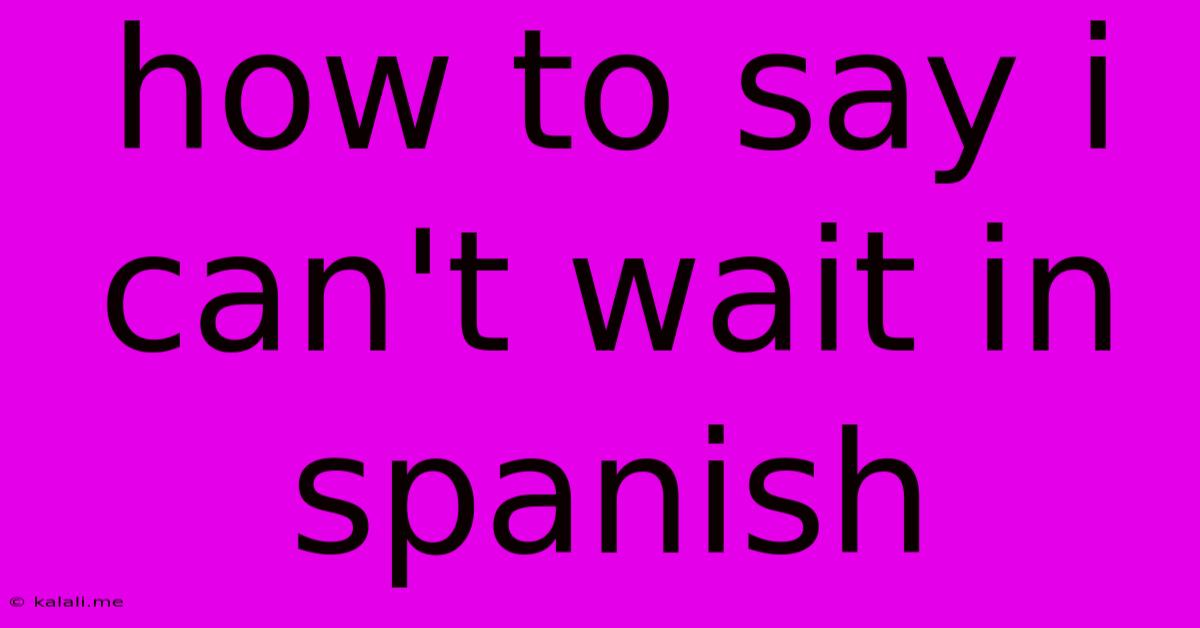How To Say I Can't Wait In Spanish
Kalali
Jun 01, 2025 · 3 min read

Table of Contents
How to Say "I Can't Wait" in Spanish: Mastering the Nuances of Anticipation
Want to express your excitement in Spanish? Learning how to say "I can't wait" isn't just about translating words; it's about capturing the feeling of eager anticipation. This guide explores various ways to express this sentiment, ensuring you choose the perfect phrase for any situation. We'll cover formal and informal options, delve into the nuances of each expression, and offer helpful tips for sounding like a native speaker.
There isn't one single perfect translation for "I can't wait," as the best choice depends on the context. However, several options accurately convey the feeling of anticipation. Let's explore them:
Common Ways to Say "I Can't Wait" in Spanish
-
Tengo muchas ganas de…: This translates literally to "I have many desires of…" or "I really want to…" It's a versatile and widely used phrase. To say "I can't wait for the party," you would say, "Tengo muchas ganas de ir a la fiesta." This is a great all-purpose option, suitable for most situations.
-
Estoy deseando…: This translates to "I'm longing for…" or "I'm looking forward to…" It implies a stronger sense of anticipation and longing than "tengo muchas ganas de." For example, "Estoy deseando ver a mi familia" means "I'm looking forward to seeing my family." This phrase is slightly more formal.
-
No veo la hora de…: This translates literally to "I don't see the hour of…" which implies impatiently waiting for something. It conveys a stronger sense of urgency and excitement than the previous options. An example is "No veo la hora de vacaciones" (I can't wait for vacation). This is a more emphatic way to express impatience.
-
Estoy ansioso/a por…: This translates to "I'm anxious for…" or "I'm eager for…" The use of ansioso/a (anxious/eager) depends on the gender of the speaker (ansioso for male, ansiosa for female). While "anxious" might seem negative in English, in this context it expresses positive anticipation. "Estoy ansioso por el concierto" means "I'm eager for the concert." Use cautiously, as it can also convey negative anxiety in other contexts.
Choosing the Right Phrase: Context is Key
The best way to say "I can't wait" in Spanish depends heavily on context. Consider the following:
-
Formality: "Tengo muchas ganas de…" and "Estoy deseando…" are generally suitable for most situations, while "No veo la hora de…" is slightly less formal.
-
Intensity: If you want to convey strong anticipation, "No veo la hora de…" or "Estoy ansioso/a por…" are more effective than "tengo muchas ganas de…"
-
Object of anticipation: The phrase you choose might subtly change the meaning. For example, saying "Tengo muchas ganas de comer" (I really want to eat) feels different from "Estoy deseando comer" (I'm longing to eat).
Going Beyond the Basics: Adding Nuance
To make your Spanish sound even more natural, consider adding adverbs to intensify your feeling:
- Muchísimo: "Tengo muchísimas ganas de ir al cine" (I can't wait to go to the movies).
- Increíblemente: "Estoy increíblemente deseando las vacaciones" (I'm incredibly looking forward to vacation).
Mastering these phrases will significantly enhance your ability to communicate excitement and anticipation in Spanish. Remember to practice using these expressions in different contexts to build fluency and confidence. Now go forth and express your eagerness in Spanish!
Latest Posts
Latest Posts
-
Best Document Width For Mobile And Desktop
Jun 03, 2025
-
What Part Of Speech Is As
Jun 03, 2025
-
How Can You Tell If The Propane Tank Is Empty
Jun 03, 2025
-
Size Of Toothpaste For Carry On
Jun 03, 2025
-
How To Pluralize A Name Ending In S
Jun 03, 2025
Related Post
Thank you for visiting our website which covers about How To Say I Can't Wait In Spanish . We hope the information provided has been useful to you. Feel free to contact us if you have any questions or need further assistance. See you next time and don't miss to bookmark.